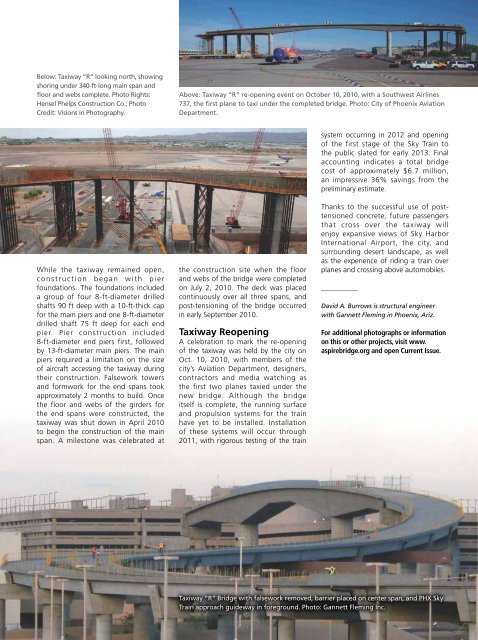ASPIRE Spring 11 - Aspire - The Concrete Bridge Magazine
ASPIRE Spring 11 - Aspire - The Concrete Bridge Magazine
ASPIRE Spring 11 - Aspire - The Concrete Bridge Magazine
Create successful ePaper yourself
Turn your PDF publications into a flip-book with our unique Google optimized e-Paper software.
Below: Taxiway “R” looking north, showingshoring under 340-ft-long main span andfloor and webs complete. Photo Rights:Hensel Phelps Construction Co.; PhotoCredit: Visions in Photography.Above: Taxiway “R” re‐opening event on October 10, 2010, with a Southwest Airlines737, the first plane to taxi under the completed bridge. Photo: City of Phoenix AviationDepartment.While the taxiway remained open,construction began with pierfoundations. <strong>The</strong> foundations includeda group of four 8-ft-diameter drilledshafts 90 ft deep with a 10-ft-thick capfor the main piers and one 8-ft-diameterdrilled shaft 75 ft deep for each endpier. Pier construction included8-ft-diameter end piers first, followedby 13-ft-diameter main piers. <strong>The</strong> mainpiers required a limitation on the sizeof aircraft accessing the taxiway duringtheir construction. Falsework towersand formwork for the end spans tookapproximately 2 months to build. Oncethe floor and webs of the girders forthe end spans were constructed, thetaxiway was shut down in April 2010to begin the construction of the mainspan. A milestone was celebrated atthe construction site when the floorand webs of the bridge were completedon July 2, 2010. <strong>The</strong> deck was placedcontinuously over all three spans, andpost-tensioning of the bridge occurredin early September 2010.Taxiway ReopeningA celebration to mark the re-openingof the taxiway was held by the city onOct. 10, 2010, with members of thecity’s Aviation Department, designers,contractors and media watching asthe first two planes taxied under thenew bridge. Although the bridgeitself is complete, the running surfaceand propulsion systems for the trainhave yet to be installed. Installationof these systems will occur through20<strong>11</strong>, with rigorous testing of the trainsystem occurring in 2012 and openingof the first stage of the Sky Train tothe public slated for early 2013. Finalaccounting indicates a total bridgecost of approximately $6.7 million,an impressive 36% savings from thepreliminary estimate.Thanks to the successful use of posttensionedconcrete, future passengersthat cross over the taxiway willenjoy expansive views of Sky HarborInternational Airport, the city, andsurrounding desert landscape, as wellas the experience of riding a train overplanes and crossing above automobiles.__________David A. Burrows is structural engineerwith Gannett Fleming in Phoenix, Ariz.For additional photographs or informationon this or other projects, visit www.aspirebridge.org and open Current Issue.Taxiway “R” <strong>Bridge</strong> with falsework removed, barrier placed on center span, and PHX SkyTrain approach guideway in foreground. Photo: Gannett Fleming Inc.
















